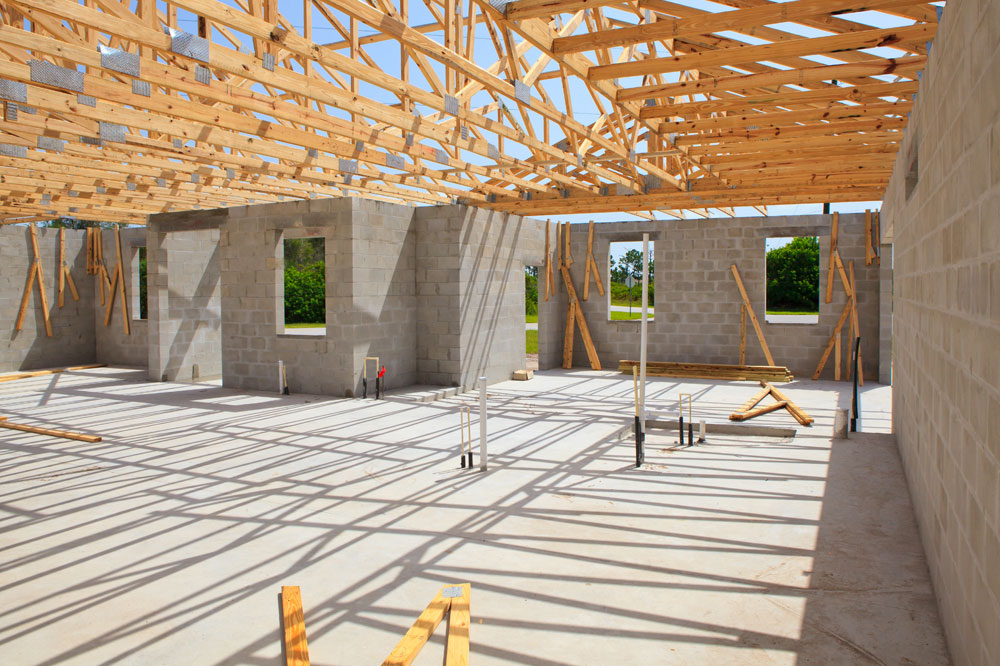|
It is our understanding that the current best practices for Central Florida residential subcontractors is to install inspection holes at filled cell locations, and not perform consolidation of grout. Is this allowed by the code? Also, what is the standard method of determining if all of the cells were completely filled with grout? MAF Response (Jerry Painter):
The inspection holes are to make sure the base of the CMU cell is clear and that the masonry grout reaches the bottom. The requirement for consolidation and re-consolidation is not forgiven any where in the structural masonry code, TMS 402/602. Sounding is one way to determine solidity. I feel a lot more comfortable with thermal photography if you can achieve the temperature differential and access to the wall. The MAF has a Structural Masonry Workshop we do 4 times a year. Last year we did 2 in Broward County for their Building Officials, Plans Analysts and others. Maybe we need to do a better job in Central Florida of reaching Code officials. MAF Response (Don Beers): I just wanted to concur with Jerry on the requirement for consolidation and reconsolidation in both commercial and residential construction built in accordance with the Florida Building Code. The code requires a minimum 3"x3" cleanout for all wall over 5'-4" in height but, as Jerry pointed out, this requirement has nothing to do with consolidation of the grout once it is in place. The problem with residential construction is there is usually no inspection on the job during grout placement so the inspector uses the cleanout as a means of determining that the cell was completely filled with grout. Unfortunately, just because the cell is filled at the bottom does not mean that the cell is filled all the way up with no void areas. Careful sounding of all grouted areas of the wall is a standard method of determining whether void areas are present in the cell, however, again as Jerry pointed out, thermal imaging is a more accurate and preferable method. I would also recommend a review of the delivery tickets for slump and times to determine if a potential problem is obvious. The grout should have been fluid (8" to 11" slump) and placed within 90 minutes of batching. This might help inform you as to the method used to determine whether all cells are completely filled.
1 Comment
Are control joints required in CMU structural backup walls in double wythe cavity systems with brick veneer on the exterior, drywall on the interior and a drainage plane between the two wythes? Quote from the Control Joint section of NCMA TEK 10-01A - “Because shrinkage cracks in concrete masonry are an aesthetic rather than a structural concern, control joints are typically only required in walls where shrinkage cracking may detract from the appearance or where water penetration
may occur.” Control joints in the CMU wall are there to accommodate movement of the wall due primarily to shrinkage of the concrete block. Uncontrolled cracking, when visible, is unsightly and when exposed to wind driven rain may allow water to enter the wall and possibly the interior of the building. The control joints both hide the cracking for aesthetic reasons and concentrates the movement in a location (the control joint) where waterproofing can be easily applied to prevent water from entering through the joint into the structure. Double wythe cavity walls containing a drainage plane between the two wythes offer the unique feature of both visually covering the CMU backup wall and preventing wind driven rain from reaching the backup wall. As stated in TEK 10-01A this eliminates the two main reasons for incorporating control joints into the structural backup CMU wall. In making the determination to eliminate control joints in the structural masonry backup of a double wythe cavity wall it is important to ensure that the section of wall will indeed be neither visible or subject to exterior weather. Particularly in long sections of wall, the elimination of control joints in a single area of the wall may produce additional stress, and thus larger more pronounced cracks, in an adjacent section of the wall exposed to visual sight or weather. Control joints may also have a structural purpose, thus elimination should not be done without the knowledge of the structural engineer for the project. There were provisions to use a fill material for hollow units to increase the fire resistance rating. In past, materials like zonolite (vermiculite) were used and a 6\" filled hollow unit would provide over 4 hours of fire resistance. Due to asbestos issues, vermiculite is no longer used. Is there a similar product that can be used? The fill material could be a variety of material, The key is what the CMU is manufactured with. If the 6" CMU is manufactured using sand and/or limestone aggregate you cannot reach a 4 hr equivalent rating. What you fill the cores with takes on the rating as the CMU. Full lightweight CMU with cores filled will meet a 4 hr requirement. A proper blend of sand and lightweight with filled cores may meet 4 hrs. The blend will have to be verified by an independent lab. Fill material can be practically anything that is fireproof itself. Perlite, sand, expanded clay aggregate and masonry cell fill (course or fine grout) are possibilities.
The Masonry Society has an excellent book on Fire Resistance of Masonry. Chapter 7 Section 722 covers calculated fire resistance in the IBC. I am attaching a link to the NCMA TEK that covers the same subject. FIRE RESISTANCE RATINGS OF CONCRETE MASONRY ASSEMBLIES - NCMA Thank you for contacting the MAF. Our goal is to make sure that when masonry is designed and installed correctly the public has the best wall system available. Be safe, Jerry M Painter, FASTM 352-494-8955 There is no specific “up” or “down” direction that block have to be laid in. You may hear a masonry say that block are manufactured “upside-down”. This means that the block molds are slightly wider on the bottom than the top. The reason is common sense – so you can lift the mold off of the freshly compacted block. The mason will usually turn the block over before he picks it up so he is holding the thicker portion of the web. It is simply easier to grip and hold the thicker end. Structurally, it makes no difference.
I am always hearing about the Perm Rating of walls and wanted to know if perm rating of masonry walls is something that is a big concern in Florida? The Perm rating of stucco is a red herring. Climate zones 1 and 2 strictly LIMIT the perm rating of vapor barriers because you don’t want to trap moisture in the wall. Standard stucco is a Class III Vapor Barrier with a perm rating between 5 and 10 which would also make it a Vapor Permeable which is better yet in Florida. Stucco is accepted as a suitable weather barrier throughout the code – and that is what you are looking for in climate zones 1 and 2 – a weather barrier – not a vapor barrier. Check out 1405.3.1 and 1405.3.2. The code is RESTRICTING the perm rating of vapor barriers – not requiring low perm barriers. Stucco, and CMU, serves as a good weather and air barrier. If you are keen on low perm vapor barriers then move up North. We don’t need them in Florida.
Correct code to use to certify CMU for a project designed under a previous edition of the FL Building Code. Our project calls for 2 hr rated block and was permitted under the 2010 FL Building Code. The engineer is not approving our submittal because the manufacturer is certifying the block under the 5th Edition, 2014 FL Building Code. He is saying that the block must be certified and tested under the 2010 code? What is going on? Your reviewing engineer is being a bit obsessive over a moot point. Table 721.3.2 in the 2007 FBC with 2009 revisions is EXACTLY the same table as 721.3.2 in the 2010 FBC which is EXACTLY the same table as 722.3.2 in the 5th Ed FBC which is EXACTLY the same table as 722.3.2 in the current 6th Ed FBC. And I do mean EXACTLY the same table. There have been no changes in this table for the past 30 years or more. 4 inch Eq Thickness of limestone agg gets you a 2 hour rating in 2007 and in 2019 - period, end of story. Additionally, the C140 testing procedures have remained exactly the same over the same 30+ years. The project was permitted under the 2010 FBC and thus is ALLOWED to be constructed under the requirements that governed at the time it was designed and reviewed (so you are not required to completely redesign the project under the current codes). It is my understanding that this does NOT mean that everyone supplying materials to the job have to climb into a time machine and retro backwards 10 years to resurrect and construct the job by historical - and out of date - standards.
That being said, your standards in the certification are not correct either way (neither 2010 or 2017. My view is that you should be testing and certifying your product under the current code (2017) and that the engineer of record should accept the current codes and standards governing construction in Florida. The question is moot because the governing procedures, and tables, have not changed. I am building a home in the panhandle and am having an argument with my architect on how much insulation to add to the walls. Do you have some basic rules of thumb I could use in determining insulation requirements? Most of the energy lost in a home is through the infiltration of outside air into the house, the hot water heating system, the efficiency of the AC unit, heat gain through the ceiling from the attic space and through the windows. The opaque exterior walls really do not contribute that significantly to the heat gain/loss, usually in the range of 6% – 10%. That being said, a modest amount of well-placed insulation can pay for itself in 2 – 3 years of energy savings.
The most common type of masonry insulation is foil backed paper stapled between the furring strips. This adds about an R3 of insulation and is the minimum amount recommended. The great thing about Florida is your temperature gradient is, by and large, small – usually less than 20 degF and for much of the year less than 5 degF. The maximum insulation recommended anywhere in Florida is ¾” Poly Iso with a foil backing. The non-foil side is glued or attached directly to the masonry and the furring strips go directly over the foil backing creating a ¾” reflective air space between the foil and the drywall. This arrangement gives you an approx. R7.8. You might want to use this on a large expanse of west facing wall where the heat gain in the afternoon can be more intense. Any more insulation than the R7.8 is a dead loss money wise and will NEVER pay for itself in energy savings. You can prove this to yourself by simply running the analysis in Comcheck or energy gauge software. You will quickly see that the exterior walls are not where your energy loss occurs. We have a project in WPB, the plans are calling out a Compressible Bond beaker at the control joints. We did not include this (Rubber, PVC CJ) in our contract, however, we did account for leaving the 3/8” of an inch as gap the control joint. Our walls are 8” CMU with a 2 hour fire rating. The EOR indicated that he wanted the joint to be 2 hr fire rated. My question is what determines the use of a rubber or PVC material verses the 3/8” gap for a control joint?? Are either of these fire rated? Please see the attached detail and EOR response. A "compressible bond breaker" in a control joint, as shown in his detail, would mean a backer rod. The backer rod or "compressible bond breaker" is pushed or "compressed" into the joint prior to caulking the 3/8" joint. It's purpose is to control the amount of caulking that goes into the joint, but more importantly, to "break" the 3 point "bonding" that occurs in the back of the joint and thus prevents the caulking from tearing open at this location.
The EOR is confused about the need for a COMPRESSIBLE material. He does want a fire rated system which is not what was called for either in the plans or in his response. His detail does not call out for a key way so that is clear. But it simply does not indicate what he is asking for. The language, as I have said, is simply another way of asking for a backer rod which he has already shown. He needs to go to https://submittalwizard.3m.com/# and pick a caulking that will give him the 2 hr rating he desires. A piece of "compressible rubber" does not carry a 2 hr fire rating. Whatever is in the control joint does NOT have to be compressible because the joint will never be compressed. Conc masonry walls shrink - always. He may be thinking about a clay brick product that would be EXPANDING and thus compressing the joint. You can fill masonry control joints with mortar if you want because they DON'T COMPRESS. Brick expansion joints have to be completely clean of mortar because the wall expands and the joint does get compressed. At this point he could solve the problem by simply changing to a fire rated caulking and eliminating the rubber filler. What he is asking for in his response carries no fire rating and is not what the words on the plans say. Another solution would be to provide a min of a 2" deep mortar joint on each side of the wall. After raking out the mortar for your backer rod and caulking you would have the usual 1 1/4" of mortar left in the joint - the same as every other head joint in the wall. This would meet the 2 hr rating by simply matching the amount of mortar as every other joint in a typical 2 hr masonry wall with face shell bedding. You would not have to go to the extra expense of using a fire rated caulking. I would be happy to discuss this with the EOR. Proper control joint construction is an area of common misunderstanding. It was nice to see that he had actually bothered to include control joints, an essential part of preventing random masonry cracking. Do you know if there is a guide to residential construction in Florida? I have been asked a couple of times about one. I refer you to R302.2.1.1 linked below. In NE Florida you can still use the MAF Guide if you are nestled into an cozy residential development and can argue Cat B – but only up to 130 (see fig 301.2(4) below). 115 doesn’t hit the state at all and the only reinforcement provisions in the FBC Residential - Chapter 6 are for seismic cat C and D (and there is no seismic in Florida). The rest of the masonry stuff in Chap 6 is just spec stuff better left in TMS. So, for the rest of Florida your best guide is the ICC 600.
Question: We are a residential engineering and design company in Central Florida, and have several builders inquiring about removing as many grouted filled cells as possible to reduce cost. They comment that we are more conservative than our competitors. We have completed our own wall calculations based on TMS 402-13 (and confirmed with NCMA software), and are comfortable with our grout filled cell spacing calculations; however, the code is less clear about filled cell requirements around openings. Some of our competitors only place a filled cell (typically with (1) vertical #5 bar) on one end of shorter window and door openings. I’ve heard several engineers cite FBC 2121.2.2.2 (see below), but of course this is only for High Velocity Hurricane Zones, and that section has several other requirements for “tie columns;” namely 2121.2.2.3 & 2121.2.2.4. In my view you can’t follow one section of the code, and ignore the others. I’ve spoken to plans examiners and inspectors, who cite Figure R606.11(1) showing reinforced filled cells on both sides and above and below openings; however, this section is prescriptive, deals with anchorage, and has unclear requirements (“Wind loads less than 30 psf,” is that design or ultimate pressure?). The most relevant code citations I can find are in R301.2.1.1, which points me to FBC, Section 2107: Allowable Strength Design, which references back to TMS 402-13. I can’t find any clear-cut requirements about reinforced filled cell placement around openings. Assuming we don’t need the reinforced filled cell for the loading requirements, or buck fastening, is there a code citation, construction guide, white paper, or other source we can reference regarding filled cell requirements around openings. If not, what is your view as far as best practices or typical industry standards. Referenced code section: 2121.2.2.2 When openings are between 3 and 8 feet (914 mm and 2.4 m) in width, such openings shall have one #5 vertical reinforcing bar at each side. The vertical bars shall be placed in concrete filled cells and shall extend into footings and into tie beams. All such bars shall be continuous from footing to tie beam. All splices, where needed, shall be 30 inches (762 mm) minimum. 2121.2.2.3 Tie columns shall be not less than 12 inches (305 mm) in width. Tie columns having an unbraced height not exceeding 15 feet (4.6 m) shall be not less in thickness than the wall or less than a nominal 8 inches (203 mm), and, where exceeding 15 feet (4.6 m) in unbraced height, shall be not less in thickness than 12 inches (305 mm). The unbraced height shall be taken at the point of positive lateral support in the direction of consideration or the column may be designed to resist applicable lateral loads based on rational analysis. 2121.2.2.4 Tie columns shall be reinforced with not less than four #5 vertical bars for 8 inch by 12 inch (203 mm by 305 mm) columns nor less than four #6 vertical bars for 12 inch by 12 inch (305 mm by 305 mm) columns nor less reinforcing steel than 0.01 of the cross-sectional area for columns of other dimension nor less than may be required to resist axial loads or bending forces. Vertical reinforcing shall be doweled to the footing and splices shall be lapped 30 bar diameters. Columns shall be tied with #2 hoops spaced not more than 12 inches (305 mm) apart. Great question: Short answer - up to the registered engineer or architect - not specifically addressed in any code that would usurp the judgement of the design professional....period.
Longer Answer: Lets start with section 2121 of the 6th Edition FBC - Building. These are historic prescriptive requirements and there has ALWAYS been confusion as to where and how they apply. Thus, we (the industry) inserted the following section into 2122 - Reinforced Unit Masonry - to try and drive home that 2121 just does not apply to masonry designed in accordance with the provisions of TMS 402/602: 2122.1Standards. The provisions of TMS 402/ACI 530/ASCE 5 and TMS 602/ACI 530.1/ASCE 6 are hereby adopted as a minimum for the design and construction of reinforced unit masonry. In addition to TMS 402/ACI 530/ASCE 5 and TMS 602/ACI 530.1/ASCE 6, reinforced unit masonry structures shall comply with Sections 2122.2 through 2122.10. 2122.2General. 2122.2.1 Section 2121 shall not apply where design and construction are in accordance with the provisions of this section. Thus you are completely correct that the provisions of 2121 are unique and independent and offer no guidance in properly designing your masonry structure - unless you want to use them in their entirety in designing your structure. Ok, now to the residential code. Not much help there. As you indicated, Figure R606.11(1) shows some interesting stuff but nothing that gives you the guidance you, as a designer, are looking for. The provisions calling for steel girding all openings is a seismic provision dealing primarily with shear. For shear in residential wind design you are generally going to distribute your shear to solid wall sections depending on their stiffness and utilizing only the un-reinforced value of masonry. If your un-reinforced shear value of the individual solid panels is not sufficient and you have to design a reinforced masonry shear wall you would generally be reinforcing around all sides of openings --- but --- that is almost never going to be the case with residential design based on wind (Florida has no seismic requirements) - and is rarely the case with low-rise commercial design. Bottom line is you are generally not going to see masonry under an opening unless it is there for crack control (not structural reasons). R301.2.1.1 references the ICC 600 in which section 405.3.2 "Openings in Masonry Walls" gives some common sense guidance to put a bar on either side of openings over 6' wide and to make sure that any bars interrupted by the opening get distributed to both sides. For openings in residential structures this is about as good as it gets. For large openings you have to make sure that the wall segment on either side will take the out of plane bending load from 1/2 the opening width. Where you have a number of large openings in a row this can be challenging. Obviously, you are always going to put a bar over the opening. I always recommend placing a vertical # 5 at all corners. Although this is not a code requirement it is standard practice. I also place a vertical #5 on either side of control joints – not a code requirement either. |
Authors:

Categories
All
Archives
June 2022
|
Masonry Resources |
MAF Websites |
Masonry Association of Florida, Inc. |PO Box 24474 , Fort Lauderdale, FL 33307
Copyright © 2017. All Rights Reserved.
Sitemap
Sitemap


 RSS Feed
RSS Feed
